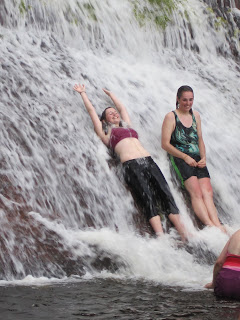We left off in Puerto La Cruz, a port city with a pretty beach you wouldn't want to swim in (and we didn't) and lots of Schwarma restaurants. We stayed less than 24 hours, before heading up to Mochima National Park, a long park covering many islands, beach towns, lagoons, etc. Unfortunately the beaches in the park are very crowded during the winter holidays (that end by the second week in January).
We stayed in Playa Colorada (Beach Colorada) for the first three days in the park. Not exactly a town, more like a built up area next to the beach where people live, and there are a few restaurants. When we arrived, the beach was obscenely crowded, like counting numbers of children per square meter crowded. One of the biggest problems with the crowds was the quantity of trash that accumulates from even one day of Venezuelan vacationing. So, we didn't spend too much time at the beach. However, on the second day we were there we kayaked to three islands with a guide and went snorkeling! The more isolated islands were truly beautiful, and the water was perfectly clear. It was Miriam's first time snorkeling, so Gabe got to teach her how and impressed Gabe greatly by jumping right in and not panicing due to the low levels of water over the coral that we had to swim over. We had a lot of fun, even though Miriam got a painful sunburn on the back of her legs.
While in Playa Colorada, we stayed at a place that hosts mostly European young adults (18-30s) to learn Spanish, travel through Venezuela, and do some community service. It had a really relaxed vibe, and we enjoyed chatting and getting to know the people who were staying there.
After Playa Colorada, we went to Santa Fe, a crummy town with a beautiful beach. We stayed at a posada directly on the beach, we literally walked out the front door into sand, and then 20 feet later, beautiful blue water. The posada was situated at a point with beaches on both sides and mountains in the distance. In the posada, we stayed in hammocks on the open-air third floor (no mosquito nets, unfortunately), which had a great breeze and an even better view.
We only stayed in Santa Fe one night, as it wasn't the safest place in the world, and headed out of Mochima park for Cumana, the closest major city.
Although Cumana is the capital of Sucre State, one of the poorest states in Venezuela, we really enjoyed the atmosphere of the city. The people were warm and friendly and people enjoyed themselves by meeting together in the many plazas of the city.
An interesting aspect of our time in Cumana was the fact that our posada (chosen for its low price) was not exactly a wholesome establishment. When we asked for a room, they replied "for how long", so we had to specify that we did in fact want a room to sleep in, instead of other services. The people were nice, so it didn't bother us, but we won't choose similar establishments in the future.
We went to a castle. :)
After a day and a half in Cumana, we took a night bus to Caracas to avoid having to pay for another hotel room. We arrived fairly early in the morning, so we waited an hour or so at the bus station, until the city buses started up. We dropped off our bags at the posada we stayed at in Caracas our first night, so we wouldn't have to carry our backpacks around all day and attract unwanted attention.
Our day in Caracas, our last day in Venezuela, we spent walking around the different parts of the city center. We went to the Caracas Museum of Contemporary Art, which we were both impressed with, especially their extensive Picasso exhibit. We also rode up and down the teleferico, the cable car that climbs above the city to a nearby mountain, from which you can see impressive panoramas of the city (where we by chance met up with the Latvian tourists that we met on the Angel Falls tour). Later, we went to the botanical gardens, which we weren't so impressed with, but were a nice break of the hustle and bustle of such a large and busy city.
In the afternoon we took the last Saturday shuttle bus to the airport to await our early morning flight back to the States! Here we are typing at an internet cafe in the airport.
Factoids:
Number of days in Venezuela: 27
Number of Americans seen: 3
Number of Westerners seen: 100+
Number of painful sunburns: 7
Number of Arepas eaten: 30+
Number of Empanadas eaten: possibly three digits??
Number of times Gabe or Miriam exclamed "GUESS WHAT, we're in VENEZUELA!": about once a day
 Our mini plane.
Our mini plane.
















































 Lagoon Mucubaji, 5km (as the bird flys) from the peak. This picture would not have been possible 30 min later, as a large cloud came by, and shrouded everything in mist.
Lagoon Mucubaji, 5km (as the bird flys) from the peak. This picture would not have been possible 30 min later, as a large cloud came by, and shrouded everything in mist.